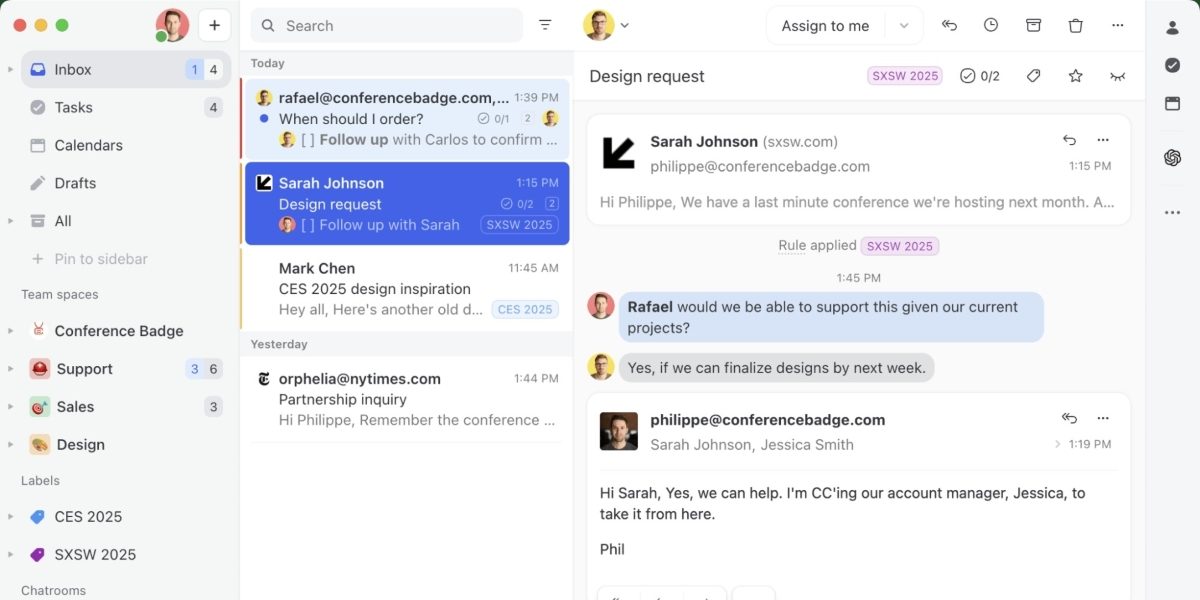In the endless shuffle of productivity apps, Slack threads, project boards, and Zoom links, there’s one constant that quietly anchors our workdays: email. It’s where deals close, clients reply, and opportunities begin. Yet, despite email’s foundational role, it’s also the one tool nearly everyone complains about. It’s slow, it’s messy, it wasn’t built for teamwork—and we all just sort of accepted it.
But not everyone.
Missive, a collaborative inbox tool co-founded by Philippe Lehoux, Etienne Lemay, and Rafael Masson, has been quietly reimagining email not as a solo activity but as a team sport. While the rest of the tech world chased AI assistants and more ways to ping your coworkers, Missive looked at the inbox and asked a radical question: What if it wasn’t broken—it just wasn’t collaborative?
Email Was Never Built for Teams
The truth is that email was never meant for teams. It was designed for one-to-one communication in an era when sending a message across a building was a big deal. So when a modern team—say, a small agency juggling dozens of clients—tries to manage its workflow through an individual inbox, the results are painfully predictable. There’s the forwarded email that no one reads. The dreaded reply-all that was meant to be a forward. The Slack ping about the email from last Tuesday. A missed deadline because someone assumed someone else had it. And all the while, important threads spiral out of control with five people CC’d and no one accountable.
The disconnect isn’t about email itself. It’s about the way it hasn’t evolved to accommodate how work actually happens.
The Rise of the Collaborative Inbox
That’s where Missive comes in—not as another inbox plugin or half-baked integration, but as a total rethinking of what email could be if it were designed for small, collaborative teams from the start.
With Missive, shared inboxes aren’t a workaround—they’re the foundation. An email thread can be assigned like a task. A teammate can comment inline, invisibly to the customer, to ask for a second opinion. A manager can get full visibility of a conversation without derailing it. And because it all happens within the inbox, there’s no more bouncing between platforms just to finish one interaction.
This isn’t just a user interface tweak. It’s a structural shift in how teams communicate.
Built for the Businesses Everyone Else Forgot
For Lehoux and his small team, the product wasn’t born from a pitch deck—it was born from necessity. Bootstrapped from the start, Missive didn’t have the luxury of big advertising budgets or sales teams. Instead, they did something increasingly rare in SaaS: they listened. Lehoux personally handled support for years, responding to every request, complaint, and feature idea. That closeness to customers meant the product didn’t evolve based on what investors thought would scale—it evolved based on what real people needed to get work done.
Many of Missive’s most defining features came not from brainstorms but from feedback. A user says, “This email thread contains tasks for three people, not just one.” So, Missive builds a way to break up a conversation and assign subtasks. Another says, “I’m jumping between my inbox, Slack, and Trello just to finish one project.” Missive integrates everything. Over time, it became more than an email tool. It became the operating system for teams whose work revolves around communication.
Simplicity as a Business Strategy
It would be tempting to describe Missive’s growth as unexpected, but that would ignore how intentional the company has been. Today, it supports over 4,000 businesses and brings in $8 million in annual recurring revenue, all without raising a dollar of venture capital. That independence has allowed the team to remain fiercely focused on their original mission: making email not just bearable but genuinely useful for the people who rely on it most.
That focus also allows them to say no. While competitors chase enterprise contracts and add complexity to justify higher prices, Missive keeps things simple. Straightforward pricing, no hidden upsells, and a focus on delivering value to every team, whether you’re a tech startup or a family-owned print shop.
Why Now?
If email has been broken for so long, why is it changing now?
The timing isn’t coincidental. According to an Adobe report, the average professional spends over three hours a day in email, and a large percentage say they still miss important messages due to disorganization. At the same time, the rise of remote work has exposed the cracks in existing systems. When your team isn’t in the same room, the stakes of miscommunication are higher, and inbox chaos is harder to hide.
And for small businesses? The pressure is even greater. They don’t have IT teams or onboarding departments. They need tools that just work. That’s why more and more of them are quietly making the shift, ditching outdated inboxes and moving toward collaborative ones that fit their workflow, not the other way around.
It’s Time to Rethink the Inbox
So maybe the question isn’t, “What’s wrong with email?” Maybe the better one is: “Why are we still using tools that weren’t built for us?”
Collaborative inboxes like Missive offer a quieter kind of progress. No hype cycles. No jargon. Just a better way to work. The future of email isn’t about doing the same thing faster. It’s about doing it together.
Everyone says email is broken. What they don’t realize is—it’s already being rebuilt. Quietly and in the hands of the people who use it most.
Outlook was built when pagers were still around. Missive was built when collaboration became the job.
And that future? It’s already in your inbox.

















